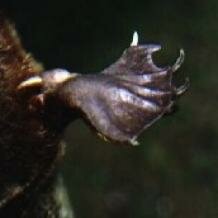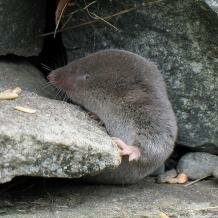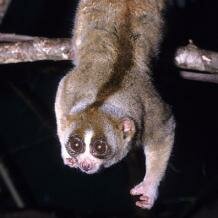Topic: Venom in mammals (and other synapsids)
Beware the venomous shrew! Yes, venomous. And convergent on some formidable lizards...
Venoms, in other words toxins injected by means of biting or stinging and typically for the purposes of prey capture or defence, have evolved independently many times. Amongst the invertebrates, well-known examples include those of the arthropods, notably the scorpions and various hymenopterans (e.g. bees, wasps), molluscs (notoriously cone shells) and certain polychaete annelids (e.g. Glycera). In the vertebrates, venom is a familiar feature of the reptiles, being known in many lizards (e.g. Varanus) and especially in the snakes, where it has, in association with specialised fangs, contributed to the group’s great ecological success. It is much less well known that several species of mammal (and mammal-like reptile) have independently evolved venom. These mammals use venom compounds and venom delivery mechanisms that are in many respects convergent with those of reptiles.
Monotremes
 Perhaps a relatively well-known example of a venomous mammal is the duck-billed platypus (Ornithorhynchus anatinus). Here the males possess an extratarsal spur on each hind limb, which is capable of delivering a cocktail of venom strong enough to kill a small animal but not lethal to humans. The venom is produced by alveolar glands in the thigh known as the crural glands, which are absent in females (that do, however, possess rudimentary spur buds). As venom is only produced during the mating season, it has been suggested that it might play a role in male-male competition.
Perhaps a relatively well-known example of a venomous mammal is the duck-billed platypus (Ornithorhynchus anatinus). Here the males possess an extratarsal spur on each hind limb, which is capable of delivering a cocktail of venom strong enough to kill a small animal but not lethal to humans. The venom is produced by alveolar glands in the thigh known as the crural glands, which are absent in females (that do, however, possess rudimentary spur buds). As venom is only produced during the mating season, it has been suggested that it might play a role in male-male competition.
The platypus venom contains many different proteins and peptides, mainly defensin-like peptides (DLPs). The cysteine-rich defensins possess antimicrobial qualities and are widely distributed, occurring in vertebrates, insects and plants.  Whilst several of these DLPs are unique to platypuses, the genes for venom production are intriguingly similar to those in snakes, the venoms of which contain similar molecules known as crotamines and crotamine-like peptides. Camilla Whittington and her colleagues concluded that “several venom components have evolved separately in the platypus and reptiles. Convergent evolution has repeatedly selected genes coding for proteins containing specific structural motifs as templates for venom molecules” (Whittington et al. 2008, Genome Research, vol. 18, p. 986). Also the venom glands have arisen completely independently in these two vertebrate groups – those of platypuses are modified sweat glands, whereas snake venom glands are derived from salivary glands.
Whilst several of these DLPs are unique to platypuses, the genes for venom production are intriguingly similar to those in snakes, the venoms of which contain similar molecules known as crotamines and crotamine-like peptides. Camilla Whittington and her colleagues concluded that “several venom components have evolved separately in the platypus and reptiles. Convergent evolution has repeatedly selected genes coding for proteins containing specific structural motifs as templates for venom molecules” (Whittington et al. 2008, Genome Research, vol. 18, p. 986). Also the venom glands have arisen completely independently in these two vertebrate groups – those of platypuses are modified sweat glands, whereas snake venom glands are derived from salivary glands.
In the closest relatives of platypus, the echidnas (Tachyglossidae), males also possess an extratarsal spur. It is, however, smaller and blunt, and so far there is no evidence for an associated functional system of toxin delivery. As the evolution of the platypus venom peptides probably preceded the divergence of platypus and echidnas, it has been proposed that a crural system might have been ancestral to monotremes and secondarily lost in the echidnas, which possess strong spines as a defence against predators.
Shrews and solenodons
In popular folklore, the venomous nature of some shrews had been acknowledged for a long time, before scientific research turned its attention to this issue. The most toxic and also best-studied species is the North American short-tailed shrew (Blarina brevicauda).  Its saliva, which is produced by enlarged submaxillary and sublingual glands, if injected close to the head, can kill a small animal such as a mouse within minutes. The toxicity is due to blarina toxin (BLTX), a serine protease that has an increased catalytic activity and inundates the circulatory system with the catalytic byproduct bradykinin, thus causing paralysis, convulsions and respiratory failure. BLTX is very similar to mammalian glandular kallikrein-1 serine proteases, enzymes that coordinate various physiological functions such as blood pressure. But more intriguingly, BLTX shows remarkable molecular convergence with gila toxin (GTX), a serine protease from the venomous Mexican beaded lizard (Heloderma horridum), which has evolved independently through almost identical functional changes. These include novel insertions increasing the length of the regulatory loops surrounding the active site as well as amino acid mutations in these loops. Based on this example (and others from venom proteins in separate lineages), it has been suggested “that the evolution of toxicity might be predictable – arising via adaptive structural modification of analogous labile regulatory loops of an ancestral serine protease – and thus might aid in the identification of other toxic proteins” (Aminetzach et al. 2009, Current Biology, vol. 19, p. 1925).
Its saliva, which is produced by enlarged submaxillary and sublingual glands, if injected close to the head, can kill a small animal such as a mouse within minutes. The toxicity is due to blarina toxin (BLTX), a serine protease that has an increased catalytic activity and inundates the circulatory system with the catalytic byproduct bradykinin, thus causing paralysis, convulsions and respiratory failure. BLTX is very similar to mammalian glandular kallikrein-1 serine proteases, enzymes that coordinate various physiological functions such as blood pressure. But more intriguingly, BLTX shows remarkable molecular convergence with gila toxin (GTX), a serine protease from the venomous Mexican beaded lizard (Heloderma horridum), which has evolved independently through almost identical functional changes. These include novel insertions increasing the length of the regulatory loops surrounding the active site as well as amino acid mutations in these loops. Based on this example (and others from venom proteins in separate lineages), it has been suggested “that the evolution of toxicity might be predictable – arising via adaptive structural modification of analogous labile regulatory loops of an ancestral serine protease – and thus might aid in the identification of other toxic proteins” (Aminetzach et al. 2009, Current Biology, vol. 19, p. 1925).
 The European Water shrew (Neomys fodiens) and the Mediterranean shrew (Neomys anomalus) possess toxic saliva, too, as do the unusual solenodons, nocturnal animals, which resemble large shrews (they are also members of the order Soricomorpha). There are only two living species, both endangered, the Cuban solenodon (Solenodon cubanus) and the Hispaniolan solenodon (Solenodon paradoxus). Similar to the venomous snakes, they inject their venom through grooved teeth, the second lower incisors (the name ‘solenodon’ is in fact derived from the Greek word for ‘grooved tooth’). This contrast with the shrews, which lack teeth specialised for venom delivery.
The European Water shrew (Neomys fodiens) and the Mediterranean shrew (Neomys anomalus) possess toxic saliva, too, as do the unusual solenodons, nocturnal animals, which resemble large shrews (they are also members of the order Soricomorpha). There are only two living species, both endangered, the Cuban solenodon (Solenodon cubanus) and the Hispaniolan solenodon (Solenodon paradoxus). Similar to the venomous snakes, they inject their venom through grooved teeth, the second lower incisors (the name ‘solenodon’ is in fact derived from the Greek word for ‘grooved tooth’). This contrast with the shrews, which lack teeth specialised for venom delivery.
Shrews and solenodons are mainly insectivorous, so what do they need a venomous bite for? It has been suggested that the toxicity of the saliva might just be a by-product of its digestive function. However, all of these species, which have very high metabolic requirements, have been observed to tackle vertebrate prey larger than themselves. And for overpowering large prey, venom might come in very handy. Alternatively, venom could be used to subdue small prey without killing it, thus permitting its storage in a preserved state for a longer time. Food hoarding behaviour has been observed in several shrew species and could be important in preventing starvation.
Slow lorises
Some researchers consider the Sunda slow loris (Nycticebus coucang), an arboreal strepsirrhine primate from Indonesia, to be the only venomous primate – a view that is controversial. The loris has been reported to have a toxic bite, but it does not produce venom by modified salivary glands.  The so-called brachial organ, a naked area of glandular skin on its arm, secretes an exudate that is then licked up by the animal during grooming. One of the major components of this exudate is a protein that exhibits extensive structural similarity to the main allergen from the domestic cat (and also shows the same unusual disulfide-bridged heterodimeric structure).
The so-called brachial organ, a naked area of glandular skin on its arm, secretes an exudate that is then licked up by the animal during grooming. One of the major components of this exudate is a protein that exhibits extensive structural similarity to the main allergen from the domestic cat (and also shows the same unusual disulfide-bridged heterodimeric structure).
Not many people are bitten by a slow loris, but when they are they exhibit a different degree of sensitivity to loris bites, with occasional anaphylaxis. It has been suggested that the glandular secretion originally evolved for communication (olfaction is very important in these nocturnal primates) and just happens to have toxic effects only on some susceptible species, such as humans. Brachial glands are also found in Bengal slow lorises (Nycticebus bengalensis) and pygmy slow lorises (Nycticebus pygmaeus).
Fossil mammals and mammal-like reptiles
There appears to be some evidence for venom delivery systems in fossil mammals and mammal-like reptiles. A number of Mesozoic mammals possessed an extratarsal spur similar (and possibly homologous) to that of extant monotremes, amongst them the carnivorous Gobiconodon (a eutriconodontan), ![]() Zhangheotherium (a spalacotheroid “symmetrodontan”) and several species of rodent-like multituberculates. This (together with the presumed “primitive” nature of the monotremes) led to the suggestion that a spur (and potentially an associated venom gland for more effective defence) might in fact have been ancestral to all mammals and lost in crown-group therians.
Zhangheotherium (a spalacotheroid “symmetrodontan”) and several species of rodent-like multituberculates. This (together with the presumed “primitive” nature of the monotremes) led to the suggestion that a spur (and potentially an associated venom gland for more effective defence) might in fact have been ancestral to all mammals and lost in crown-group therians.
Other extinct forms bore certain dental features that are reminiscent of the grooved venom fangs of colubroid snakes and have been interpreted as evidence for a venom delivery system. The upper canine teeth of Euchambersia, an advanced mammal-like reptile (therapsid) from the Late Permian, are enlarged and equipped with a groove running from the base and across the outer, labial (cheek-facing) surface. A venom gland, presumably located in a recess from the upper jaw, is thought to have secreted toxins that were channeled to the base of the canine. The pantolestid Bisonalveus browni, a small eutherian mammal from the late Palaeocene of North America, was also equipped with large, dagger-like upper canines that were deeply grooved on their anterior side.  From different deposits of a similar age, canine teeth of another (yet unidentified) mammal were recovered, with a groove extending along the length of the labial side. These finds prompted the conclusion by Richard Fox and Craig Scott that “mammals have been much more flexible in the evolution of [venom delivery systems] than previously believed” and that “small predatory eutherians have paralleled colubroid snakes in evolving salivary venoms and their delivery systems several times independently” (Fox & Scott 2005, Nature, vol. 435, p. 1091). This idea of several independent evolutionary origins of venomous saliva in diverse mammalian groups is further reinforced by evidence for a venom delivery apparatus including grooved lower incisors in the extinct shrew genus Beremendia from the Early Pleistocene of Spain.
From different deposits of a similar age, canine teeth of another (yet unidentified) mammal were recovered, with a groove extending along the length of the labial side. These finds prompted the conclusion by Richard Fox and Craig Scott that “mammals have been much more flexible in the evolution of [venom delivery systems] than previously believed” and that “small predatory eutherians have paralleled colubroid snakes in evolving salivary venoms and their delivery systems several times independently” (Fox & Scott 2005, Nature, vol. 435, p. 1091). This idea of several independent evolutionary origins of venomous saliva in diverse mammalian groups is further reinforced by evidence for a venom delivery apparatus including grooved lower incisors in the extinct shrew genus Beremendia from the Early Pleistocene of Spain.
It is, however, difficult to reconstruct the function of a structure in fossil species, and grooved teeth do not necessarily indicate an envenomation apparatus. A comparative study on anterior tooth morphology of representatives of all eutherian orders found no simple correlation between canine groves and venom delivery. Non-venomous mammals such as coatis, pteropodid bats and anthropoid primates possess similar grooves, which have presumably evolved independently in these groups (the function of the grooves remains unknown, but they might provide structural support). So the question about the evolutionary origin of venom in mammals remains controversial.
Cite this web page
Map of Life - "Venom in mammals (and other synapsids)"
https://mapoflife.org/topics/topic_316_venom-in-mammals-and-other-synapsids/
November 29, 2020

